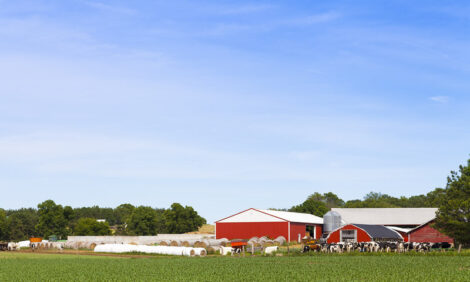



Digital Dermatitis Is a Worldwide Lameness 'Plague'
GLOBAL - Digital dermatitis (DD) is currently the global ‘plague’ of cattle lameness which must be caught early if control is to be achieved.This is if structural alterations in the bone are to be avoided, Russian farmers heard at a recent DeLaval conference in St Petersburg.
Roger Blowey, a leading cattle lameness veterinarian from Gloucestershire, England, advised delegates that through a holistic approach, digital dermatitis can be controlled before infection changes the pedal bone.
This requires a combination of regular foot baths, farm hygiene and appropriate foot trimming but is helped greatly by a fundamental understanding of hoof structure.
Mr Blowey likened a cow’s foot to a human finger, saying that, like a finger nail, a slow growing horn is produced at the coronary band and major impact can cause damage and bruising.
Growing 5mm a month, the hoof does not show visible signs of damage – or a solar ulcer - until weeks or months have passed.
“Eventually a solar ulcer protrudes through the sole of the foot,” said Mr Blowey. “Just like a finger nail, an impact causes bruising. However, it is easy to see a bruise on a human finger.”
This represents a diagnostic problem and means milk production can be lower as much as two months prior to any sign of lameness.
Citing the findings of two studies, Mr Blowey said there is reasonable evidence to show that each case of lameness costs around 400 litres of milk in production.
The next ‘extremely important’ step is to remove the solar ulcer by ‘dishing’ out the hoof.
“The likelihood of a foot healing is hit hugely by infection,” he added. “Feet should be trimmed so they take weight on the hoof wall, around the outer edge.”
Referring to the recent rise of DD cases in the UK, Mr Blowey warned that if infections do get into the hoof, toe necrosis can occur, leading to changes in bone structure.
When foot trimming, it is important to maintain a decent sized hoof to account for the size of the animal, with Mr Blowey saying that cow foot size can vary up to 50 per cent.
He called for a change to hoof trimming protocols, adding that, ‘just like teats, hoof size reflects the size of the cow’.
His three ‘take home’ messages were
- Prevention is the most important feature of digital dermatitis control
- Early treatment can avoid changes in the pedal bone
- Digital Dermatitis is currently the ‘plague’ of cattle lameness worldwide
Michael Priestley
News Team - Editor
Mainly production and market stories on ruminants sector. Works closely with sustainability consultants at FAI Farms



